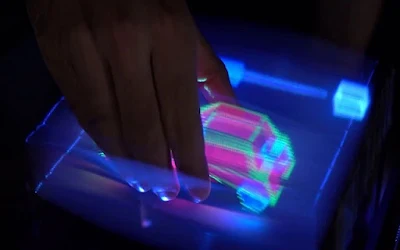Video: The first interactive 3D display screen in the world has been made
The first interactive 3D display in the world has been unveiled by a group of scientists and researchers, enabling users to engage directly with virtual light projections.
It is crucial to clarify that holograms are made with volumetric scanning screens, which project images at various heights onto a diffuser—an oscillating solid surface—roughly 3,000 times per second.
This surface creates the illusion of a three-dimensional object without the need for protective gear or special glasses.
Although the diffuser is moving so quickly in this instance that it is invisible to the human eye, we could break the hologram, the device, or even lose a finger if we attempt to physically interact with it, for instance, using our hands.
Therefore, Elodie Bouzbib of the Public University of Navarra and a group of researchers created flexible, dispersed strips with a particular function.
The team first experimented with various tape types and materials in order to accomplish this. In the end, they decided that rubber bands would be the best material to use when developing their FlexiVol system.
You can interact with, control, and eventually manipulate these holographic objects through the flexible diffuser thanks to this system and gestures you are already familiar with from your phone's touch screen (press, rotate, etc.).
These days, a 3D mouse is used to interact with 3D holograms.
In order to demonstrate the efficacy of their system, they ran three tests where participants used their FlexiVol system and a 3D mouse to carry out various tasks.
The FlexiVol outperformed a 3D mouse in each of the three tests, particularly the docking test, which required the user to position one object inside another.
They are currently trying to enhance this system even more by simulating tactile feedback with conductive wires or focused ultrasound.

